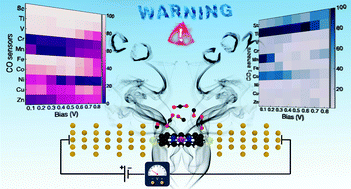Highly sensitive and low-power consumption metalloporphyrin-based junctions for COx detection with excellent recovery†
Abstract
The development of cost-effective and eco-friendly sensor materials is needed to realize the application of detectors in daily life—such as in the internet of things. In this regard, monitoring air pollutants such as carbon monoxide (CO) and carbon dioxide (CO2), mainly emitted by anthropogenic sources from daily human activities, is of great importance. In particular, developing a susceptible and portable CO2 sensor raises a dilemma because of the chemical inertness and non-polarity of CO2 molecules. We find that porphyrin-based materials, exploited by nature in biological systems, are a playground to search for such sensor materials. Using density functional non-equilibrium Green's function formalism, we fully screen all 3d metalloporphyrin (MPor) based devices to find efficient CO and CO2 gas sensors. Our detailed analysis of the adsorption energy, molecular orbitals, transmission spectra, sensitivity, and recovery time reveals that the nature of central M alters the efficiency of MPor gas detectors. We find that CO and CO2 can be monitored using, respectively, CoPor- and TiPor-based devices. The estimated sensitivity is around 100%, along with a fast recovery time at very low bias voltages (V ≥ 0.5 V), which turn metalloporphyrins into promising candidates for the widespread development of enhanced CO and CO2 sensors awaiting further experimental validations.



 Please wait while we load your content...
Please wait while we load your content...